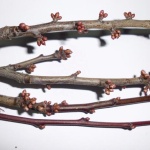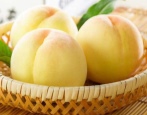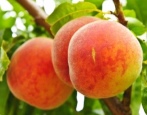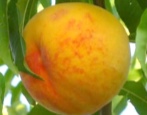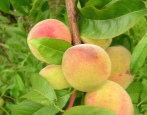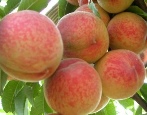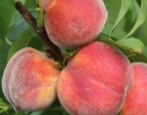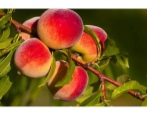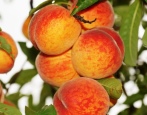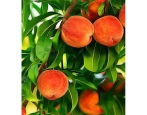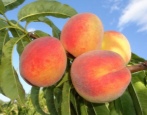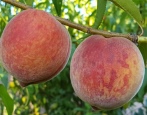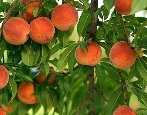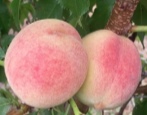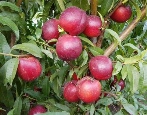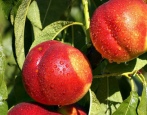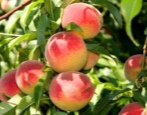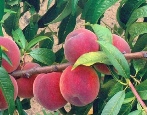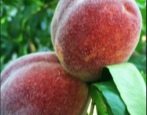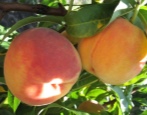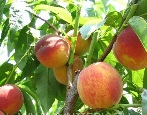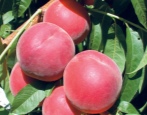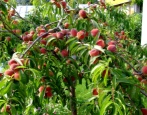
- Name synonyms: Zolotoj Triumf
- Growth type: undersized
- Ripening period: early
- Self-fertility: self-fertile
- Appointment: for fresh consumption
- Transportability: high
- Early maturity: begins to bear fruit in the 2-3rd year after planting
- Winter hardiness: high
- Disease and pest resistance: has immunity
- Fruit weight, g: 255-280
Columnar fruit trees appeared in gardens at the end of the last century, although they were bred much earlier. Unfortunately, the conservatism of the Russian mentality did not allow the species to take its rightful place in private gardens. Incredible compactness, ease of cultivation, strong immunity, large fruit size, high transportability and adaptive abilities make columnar crops simply invaluable helpers in obtaining high yields of useful fruits.
The Zolotoj Triumf peach variety (synonymous with Zolotoj Triumf) is part of the columnar peach line and has many advantages. Its fruits are intended for fresh consumption, beautiful and aromatic jams, preserves, jam, compotes are made from them. Even a novice gardener can grow a Golden Triumph.
Description of the variety
A low-growing plant, whose height ranges from 1.4-1.5 meters, has a compact cylindrical crown. In the usual sense, it is difficult to call it a crown - it looks more like a stake covered with foliage, and at the time of harvest it is densely covered with large peaches. Small side shoots have short internodes, which gives the impression that the fruit grows literally from the trunk.
The leaves are lanceolate, dark green, the end is elongated and pointed. The bare leaf plate has wavy edges speckled with small frequent denticles, the central vein is clearly visible, the lateral branches are less visible. The plant blooms with relatively large fragrant flowers of pink shades - at this time it is very decorative.
Fruit characteristics
Large (255-280 g) rounded fruits are covered with a dense medium pubescent skin. The cover color is orange-yellow, and a dark red, burgundy blush almost completely covers the surface. Fruits have a rich chemical composition, which includes:
- pectins;
- beta carotene;
- essential oils;
- organic acids;
- macro- and microelements;
- group of vitamins - A, E, K, C, B1, B2, B3 (PP), B4, B5, B6 and B9.
The seed contains amygdalin and bitter almond oil.
Taste qualities
Juicy orange pulp of dense consistency has a characteristic delicate, but pronounced fruity aroma, dessert nectar sweetness.
Ripening and fruiting
The variety belongs to the early ripening category - they start harvesting at the beginning of August, but wide distribution across the regions makes adjustments in exact terms. The rapidity of the Golden Triumph, as in almost all columnar fruit plants, is beyond praise - the plant gives the first fruits in the second or third year after planting.
Yield
The declared yield is from 10 to 12 kg per tree, but everything is known in comparison. Considering the compactness, the almost complete absence of a crown and the ability to plant 3-4 trees instead of one full-fledged tree on the site, these are very high rates.
Growing regions
Despite the fact that the homeland of the peach has a hot climate and a long summer, the columnar Golden Triumph, with its high frost resistance, can be grown in the central regions of the Russian Federation, in the middle lane, in the Urals, Altai, and the Far East.
Self-fertility and the need for pollinators
The variety is self-fertile, bears excellent fruit without pollinating varieties, however, cross-pollination always has a beneficial effect on the quantity and quality of the crop.
Growing and care
For planting, choose well-lit areas with protection from northern winds. Groundwater should not be closer than 1.5 meters from the surface. Wetlands and the constant presence of moisture inevitably provoke the appearance of putrefactive bacteria and fungal diseases, which even a strong immune system is unable to cope with.
When choosing planting material, one should remember about the features of columnar varieties - annual seedlings take root best of all, since this group does not respond well to transplantation. Otherwise, everything is traditional - ZKS (closed root system) is always better than OKS (open roots). If the choice fell on the ACS, then a thorough visual examination of the shoot and the root system is necessary. Requirements:
- lack of dry roots;
- minimum length - 15 cm, ideally - from 20 cm;
- the presence of shoot buds and good development of the trunk.
Planting dates are classic - spring or autumn. It all depends on the area where the peach is to grow and bear fruit. In the southern regions, they prefer autumn planting, since winter comes late, the temperature drop is small and the plant has time to adapt, take root and get stronger. In areas of risky farming, one has to resort to spring planting.
The landing pit is prepared in advance - for spring it is equipped in the fall and vice versa. If you have to prepare a pit during the planting season, then they do it two weeks before the event. The optimal size is 50x50x60 cm, at the bottom you need a 10-cm drainage layer of pebbles, gravel, crushed stone or broken brick. Simultaneously with the drainage device, a support for the fragile stem is installed.
The removed soil is enriched with organic matter (humus, compost, bird droppings), superphosphate, complex mineral fertilizers, and wood ash. If the soils are heavy, clayey, add a large amount of river sand. After planting, the soil is compacted, well watered with settled water. The next day, loosen or cover with a layer of mulch made from peat, straw or cut grass. Further care consists in watering, weeding, fertilizing and sanitary pruning.
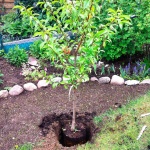
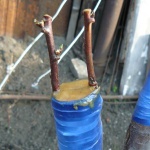
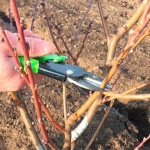
Frost resistance and the need for shelter
The variety has high frost resistance and is able to withstand temperatures critical for fruit plants - up to minus 30–38 ºC.
Disease and pest resistance
Golden Triumph has strong immunity and is practically not affected by diseases and pests, therefore, the use of preventive treatments with insecticides and fungicides depends on local conditions and the wishes of the owner.
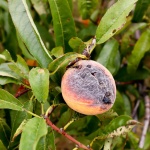
Requirements for soil and climatic conditions
The columnar variety does not tolerate swampy soils, grows and bears fruit in good lighting, therefore it is not suitable for areas with rainy climatic conditions, areas with infertile soil and the closest possible groundwater. But its drought resistance provides excellent development in a climate with hot summers, early maturity will allow you to get a harvest even during a short summer period.
